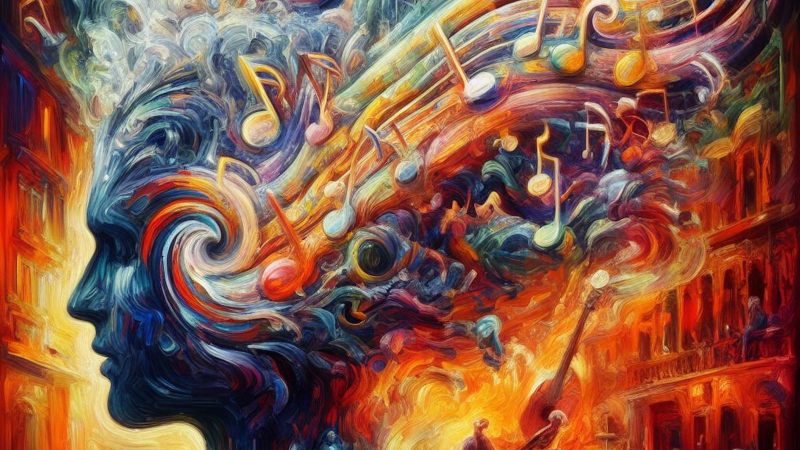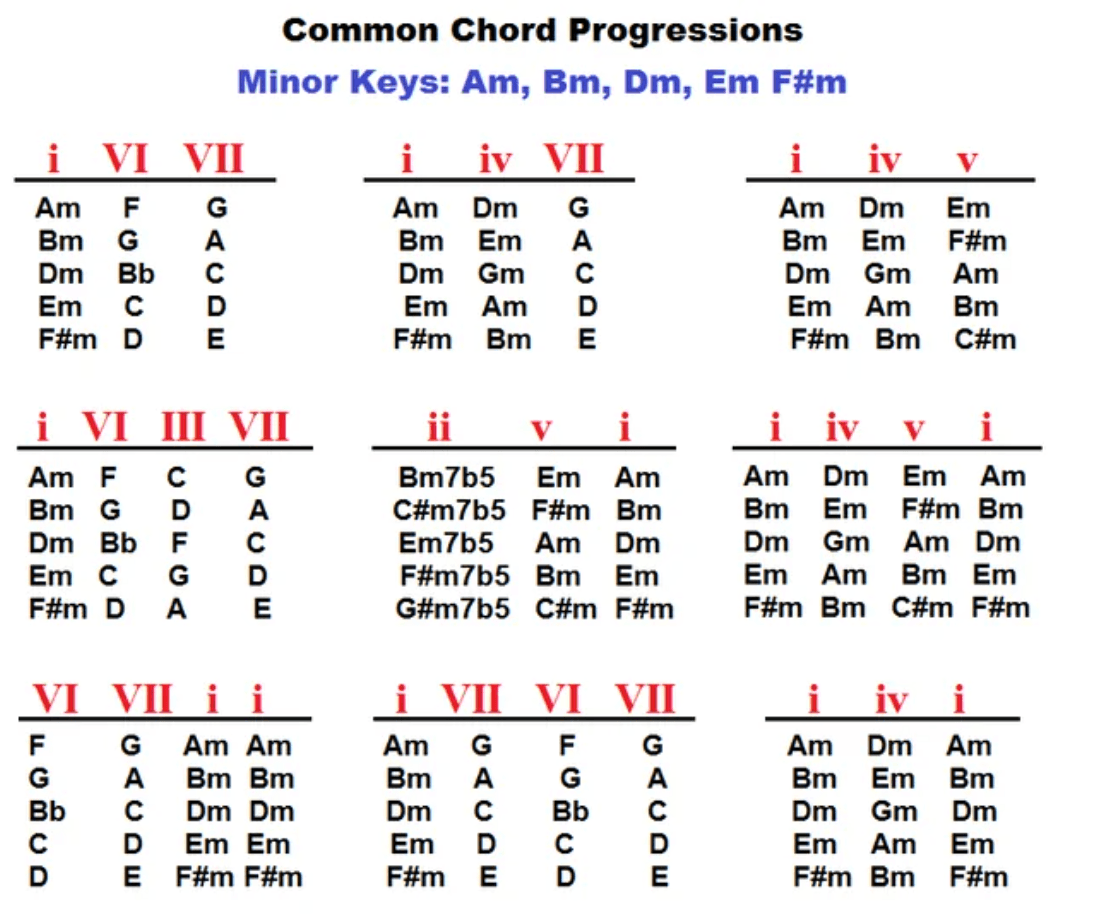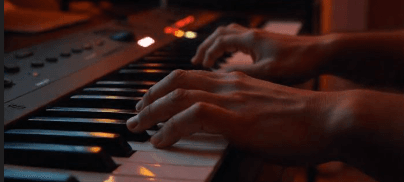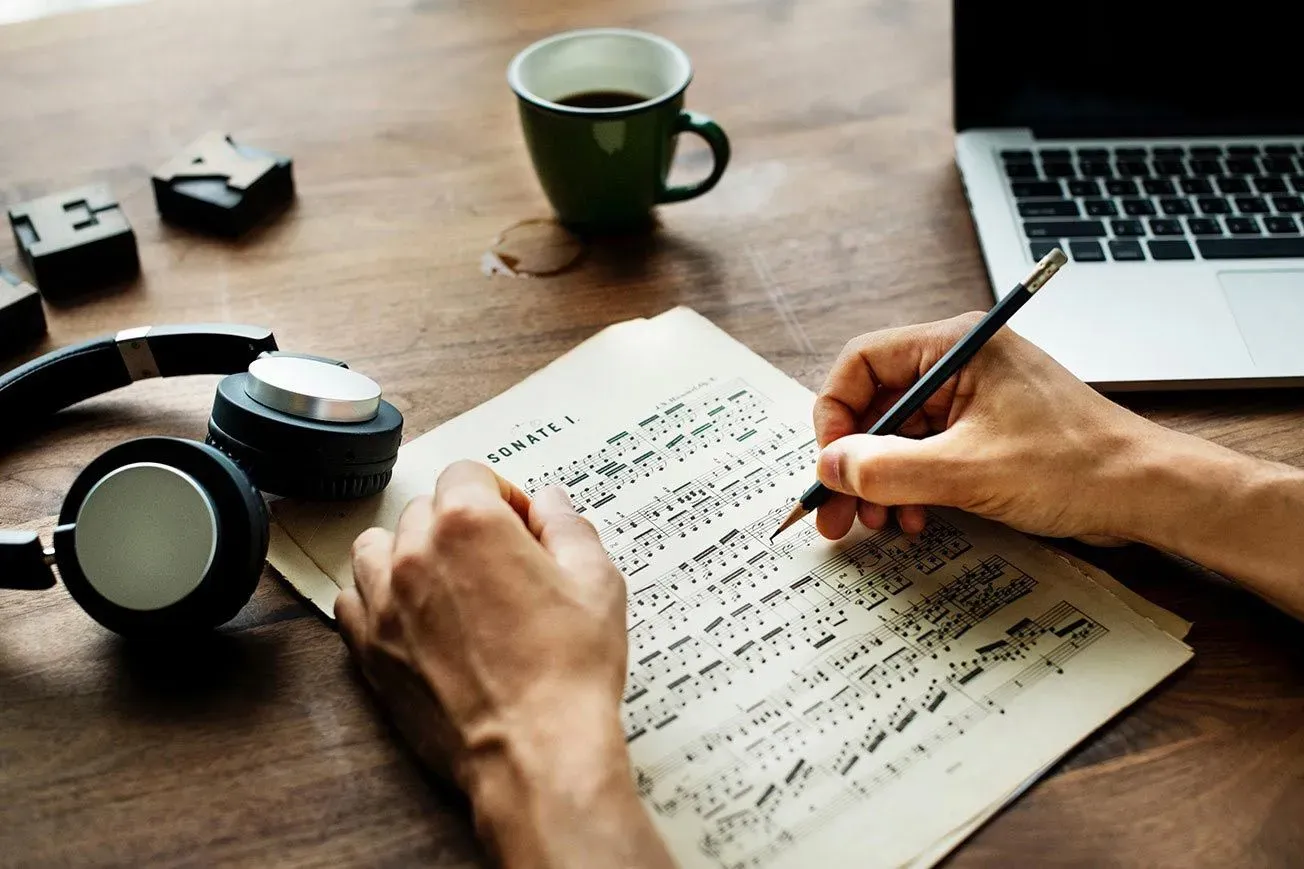Welcome to your ultimate guide for crafting the perfect AI music prompt! Whether you're a seasoned musician or just starting out, this guide will show you how to harness the power of audio AI tools to capture the essence of any mood in your music.

Deciphering Musical Emotions: The Role of Musical Elements
Music transcends mere sound, acting as a conduit for conveying a spectrum of emotions.
To truly understand the vibe of a musical piece, one must become fluent in the language of music – a language where keys, genres, BPMs, and keywords form the foundational 'alphabet'.
The Influence of Keys on Emotional Tone
The choice of key in a composition is critical in setting the emotional tone.
Each key carries with it a distinct feeling, capable of evoking a particular emotional response from the listener.
Major Keys: Brightness and Joy
Major keys often exude a sense of brightness and are frequently associated with happy, buoyant emotions.
A piece in C Major might feel unequivocally joyous, while G Major can offer a sense of tranquil contentment.
Minor Keys: Depth and Introspection
Conversely, minor keys tend to convey a deeper, sometimes sadder or more introspective mood.
The contemplative ambiance of A Minor or the poignant sorrow of E Minor can tug at the heartstrings in ways major keys simply do not.
Genre: The Cultural Context of Vibe
The genre provides the cultural context that shapes the listener's perception. It is the genre that often sets the expectations for the emotive journey the music will take.
Classical and Orchestral: Grandiosity and Elegance
Classical music, with its rich textures and dynamic range, can convey a sense of grandiosity and elegance.
It’s in the sweeping movements of an orchestral piece that one might find the pinnacle of emotional expression.
Pop and Rock: Accessibility and Energy
Pop and rock genres, known for their accessibility and energy, can quickly elevate the mood, offering an upbeat tempo that resonates with a wide audience.
BPMs: The Heartbeat of Emotion
The beats per minute (BPM) in a piece of music essentially serve as the heartbeat, providing the rhythm to which the emotions of the piece pulse.
Upbeat Tempos: Excitement and Frenzy
Faster BPMs generally contribute to a feeling of excitement or frenzy, perfect for dance genres that aim to get listeners moving.
Slower Tempos: Calmness and Reflection
Slower BPMs, on the other hand, can induce a state of calmness or reflection, often utilized in ambient or meditative music genres.
Keywords: Sharpening the Emotional Focus
Keywords serve as a guide, sharpening the focus of the music’s intended emotional impact. They are the descriptors that composers and AI music tools use to fine-tune the emotional direction of their work.
Descriptive Language: Shaping Listener Expectations
Using specific descriptive language like 'euphoric', 'sombre', or 'ethereal' can shape listener expectations and guide the emotional journey before a single note is played.
Harmonizing Elements for a Cohesive Vibe
The true artistry in music production lies in harmonizing these elements to create a cohesive vibe.
By carefully selecting each musical component, from the key to the genre, the BPM, and the keywords, musicians and audio AI tools like Empress can craft a piece that resonates with the intended emotional landscape.
The ability to combine these elements effectively is what sets a masterful composition apart.
It's not just about the individual pieces but how they blend to create the full picture – the ultimate vibe that listeners will not only hear but feel deeply.
Also: Read More about AI's Multi-Dimensional Role in Shaping Music
The Mood Dictionary: Matching Elements to Emotions
Explore the Mood Dictionary, a tailored lexicon where musical elements are meticulously matched with emotional landscapes.
This guide deciphers the language of music in game design, revealing how keys, genres, BPMs, and keywords can evoke specific emotions.
It's a resource designed to aid in the selection of the perfect audio AI tool-generated ambiance, ensuring every soundtrack element aligns harmoniously with your game's intended vibe.

Lively Excitement: Major Keys and Fast Tempos
- Mood: Joyful, Energetic
- Key: E Major
- Genre: Pop, Dance
- BPM: 120-130
- Keywords: Uplifting, Euphoric, Vibrant
When music bursts forth in E Major at a brisk tempo, it creates an atmosphere of lively excitement. This vibe is the hallmark of pop anthems and dance floor hits that are designed to be uplifting and energizing. The fast beats per minute (BPM) between 120-130 get the heart racing, embodying an euphoric and vibrant feeling that's hard to resist.
Melancholic Reflection: Minor Keys and Moderate Tempos
- Mood: Introspective, Sombre
- Key: A Minor
- Genre: Blues, Acoustic
- BPM: 60-70
- Keywords: Melancholic, Reflective, Deep
The mood shifts with A Minor's introspective pull, a key that often brings depth and a sombre touch to music. It's the key of choice for blues and acoustic genres where the moderate tempos of 60-70 BPM allow for a reflective and melancholic resonance. This combination invites listeners to a deeper emotional state, encouraging contemplation and a profound connection to the music.
Epic Grandeur: Modal Keys and Variable Tempos
- Mood: Heroic, Majestic
- Key: Dorian Mode
- Genre: Orchestral, Soundtrack
- BPM: Flexible
- Keywords: Epic, Cinematic, Grand
Dorian Mode evokes a sense of epicgrandeur, a mood that is both heroic and majestic. This mode is versatile, adaptable to variable tempos, making it a favorite in orchestral pieces and epic soundtracks that aim to tell a grand story. The keywords "epic," "cinematic," and "grand" often accompany such compositions, hinting at their expansive nature and the vast emotional landscapes they can paint.
Tranquil Serenity: Pentatonic Keys and Slow Tempos
- Mood: Calm, Peaceful
- Key: C Pentatonic
- Genre: Ambient, New Age
- BPM: 40-50
- Keywords: Soothing, Ethereal, Gentle
The C Pentatonic key is the essence of tranquilserenity. It's commonly used in ambient and new age music, genres that prioritize a calm and peaceful aura. Slow tempos, ranging from 40-50 BPM, create a serene soundscape, where each note seems to float in space, offering a soothing and gentle reprieve from the chaos of everyday life.
Dark Intensity: Diminished Keys and Intense Tempos
- Mood: Mysterious, Tense
- Key: G Diminished
- Genre: Industrial, Darkwave
- BPM: 100-110
- Keywords: Ominous, Foreboding, Intense
In the realm of G Diminished, music takes on a dark intensity. This key, when combined with the intense tempos of 100-110 BPM, is often found in industrial and darkwave genres, known for their ominous and foreboding presence. The vibe is mysterious and tense, filled with an edge that can both intrigue and unsettle, creating a compelling musical experience that's as intense as it is unforgettable.
Romantic Sentiment: Lydian Keys and Fluid Tempos
- Mood: Loving, Dreamy
- Key: F Lydian
- Genre: Soft Rock, R&B
- BPM: 80-90
- Keywords: Tender, Passionate, Serene
The Lydian mode, with its dreamlike and almost magical lift, is perfect for expressing romance in music. It's often used in genres where the expression of love and affection is central, supported by a tempo that sways like the rhythm of a heart in love.
Festive Joy: Mixolydian Keys and Upbeat Tempos
- Mood: Celebratory, Buoyant
- Key: B Mixolydian
- Genre: Folk, World
- BPM: 110-120
- Keywords: Festive, Lively, Cheerful
For music that captures the spirit of celebration and communal joy, the Mixolydian mode offers a cheerful yet grounded vibe. It's a common choice for music that accompanies festivals and gatherings, where the beat calls for dancing and rejoicing.
Contemplative Calm: Aeolian Keys and Steady Tempos
- Mood: Reflective, Soothing
- Key: A Aeolian
- Genre: Jazz, Lounge
- BPM: 70-80
- Keywords: Contemplative, Mellow, Smooth
The Aeolian mode, or natural minor scale, provides a sense of soothing reflection, often utilized in genres that encourage introspection and a cool, laid-back atmosphere. The tempo complements this by providing a steady, unhurried rhythm that allows for contemplation.
Brooding Intensity: Phrygian Keys and Varied Tempos
- Mood: Edgy, Intense
- Key: E Phrygian
- Genre: Metal, Progressive
- BPM: Varied
- Keywords: Brooding, Mysterious, Bold
The Phrygian mode is known for its exotic and somewhat tense sound, ideal for creating a mood of edgy intensity. It's often heard in genres that push the boundaries of traditional music, where the tempo can fluctuate to enhance the dramatic effect.
Blissful Euphoria: Ionian Keys and Lively Tempos
- Mood: Blissful, Uplifting
- Key: C Ionian
- Genre: Gospel, Electro-Pop
- BPM: 100-120
- Keywords: Joyous, Radiant, Inspiring
The Ionian mode, or major scale, is the epitome of a blissful and uplifting mood. It's a staple in genres that aim to inspire and evoke a sense of euphoria, with tempos that complement the positive and radiant vibe.
Mystical Ambiance: Locrian Keys and Open Tempos
- Mood: Ethereal, Mysterious
- Key: B Locrian
- Genre: Experimental, Ambient
- BPM: Open
- Keywords: Mystical, Enigmatic, Atmospheric
The Locrian mode is perhaps the most enigmatic of all, often used to create an otherworldly or mystical atmosphere. It's not commonly used, which makes it perfect for experimental genres that aim to transport the listener to another realm, where tempo is less defined and more open to interpretation.
Nostalgic Longing: Harmonic Minor Keys and Moderate Tempos
- Mood: Wistful, Yearning
- Key: D Harmonic Minor
- Genre: Ballad, Classical
- BPM: 65-75
- Keywords: Nostalgic, Longing, Melancholic
The harmonic minor key is a treasure trove for conveying nostalgia and longing. It carries the depth of minor keys with a twist of poignant sharpness that tugs at memories. Ballads and classical pieces in this key often have a moderate tempo, allowing each note to resonate with the listener's own sense of yearning.
Invigorating Power: Whole Tone Scales and Dynamic Tempos
- Mood: Energetic, Powerful
- Key: Whole Tone Scale
- Genre: Jazz Fusion, Electronic
- BPM: 120-140
- Keywords: Thrilling, Invigorating, Intense
The whole tone scale is synonymous with a sense of unrestrained power and boundless energy. It's frequently employed in genres that thrive on innovation, like jazz fusion and electronic music, and is often paired with dynamic tempos to create an exhilarating listening experience.
Solemnity and Awe: Gregorian Modes and Slow, Reverent Tempos
- Mood: Solemn, Awe-Inspiring
- Key: Gregorian Modes
- Genre: Choral, Sacred Music
- BPM: 30-40
- Keywords: Majestic, Reverent, Sacred
Rooted in the tradition of sacred music, the Gregorian modes evoke a sense of solemnity and awe. Choral and sacred music often use these modes to create a deep sense of reverence, paired with tempos that command a majestic stillness.
Playful Whimsy: Lydian Augmented and Sprightly Tempos
- Mood: Quirky, Playful
- Key: F Lydian Augmented
- Genre: Children’s Music, Musical Theatre
- BPM: 80-130
- Keywords: Whimsical, Lighthearted, Fun
The Lydian augmented scale adds a twist of quirkiness to the cheerful Lydian mode, perfect for playful and whimsical music. This scale is often found in children’s music and musical theatre, where a sprightly tempo can bring a smile and a light heart.
Introspective Solitude: Natural Minor Keys and Languid Tempos
- Mood: Introspective, Solitary
- Key: A Natural Minor
- Genre: Solo Piano, Folk
- BPM: 50-60
- Keywords: Introspective, Pensive, Solemn
The natural minor key is the go-to for music that speaks to the soul's solitary journey. Often used in solo piano pieces and introspective folk music, it's paired with languid tempos that provide space for personal reflection and solace.
Adventurous Journey: Mixolydian b6 and Robust Tempos
- Mood: Adventurous, Bold
- Key: E Mixolydian b6
- Genre: Film Score, World Music
- BPM: 90-105
- Keywords: Adventurous, Exotic, Bold
The Mixolydian b6 is an adventurous mode that evokes the spirit of exploration and boldness. It's a popular choice for film scores and world music, where robust tempos underscore the thrill of adventure and discovery.

Crafting Your Own Mood: Questions to Guide Your Vision
When you're at the helm of a musical piece, envisioning the mood is like painting on a sonic canvas.
To find the right hues and strokes in music, here are some pivotal questions to consider:
Identifying the Core Emotion
What emotion am I aiming to evoke? Begin by pinpointing the primary emotion you wish to express. Is it joy, sorrow, excitement, or perhaps nostalgia? This emotional core will guide the selection of every other musical element.
Complementing Narrative Elements
Is there a scene or story that I want to complement? Music often serves as a narrative tool, enhancing the storytelling experience. Consider the themes and settings of the story or scene you wish to underscore. Are you scoring a serene sunrise or a thrilling chase?
Shaping the Listener's Experience
How do I want my audience to feel as they listen? Reflect on the listener's journey. Are you aiming for your audience to feel inspired, profoundly touched, or utterly astonished? The music you create isn't merely listened to—it's profoundly felt and lived. Aim to craft a journey that leaves a lasting impact.
By answering these questions, you create a framework that helps in selecting the right keys, genres, BPMs, and keywords.
This methodical approach ensures that every musical decision aligns with the intended mood, making the process of using AI music tools and audio production techniques more targeted and effective.
Whether you're a seasoned musician or an enthusiast venturing into the world of music creation with AI music prompts, these guiding questions are a beacon in the complex yet exhilarating process of crafting your own unique musical mood.
Empress: Your Partner in Music Creation
Empress is not just an AI music tool; it's your creative partner that simplifies the music-making process. Use Empress to enhance your audio production, and let your creativity flow unbounded.
FAQs on Harnessing AI for Musical Moods
Q1: How does an AI music tool help in audio production?
An AI music tool streamlines audio production by offering quick generation of melodies, harmonies, and rhythms, aiding creativity and efficiency.
Q2: Can I customize AI-generated music to fit a specific genre?
Yes, you can customize AI-generated music to fit specific genres by adjusting the parameters such as key, tempo, and instrumentation within the AI's interface.
Q3: What's the best way to choose a key for my mood?
To choose a key for your mood, consider the emotional tone you want to set; major keys often evoke happiness, while minor keys can convey sadness or tension.
Q4: Are there any BPMs that universally evoke a certain feeling?
While no BPMs universally evoke a certain feeling, slower tempos tend to be calming, and faster tempos can be energizing.
Q5: How do I use keywords effectively in creating a music prompt?
Use keywords effectively in creating a music prompt by selecting words that encapsulate the emotion or atmosphere you're aiming to achieve, guiding the AI towards your desired mood.
Follow the future of music with Empress. Check out our blog to learn how you can effectively use these AI music tools.


